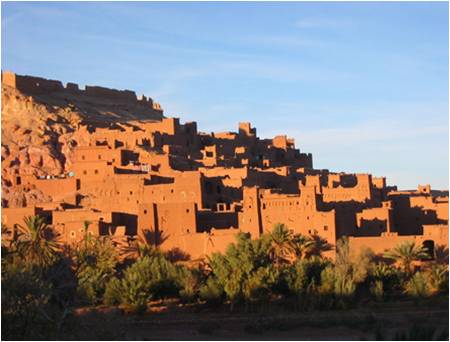
“The thing that hit me in the eye, right from the beginning, was that an enormous amount of use was made of mud! The first thing I discovered was that mud is one thing in one place and a different thing in another. It is used for different purposes and is used in different ways! There are different techniques of sticking it together and making it into a wall or whatever. This varied considerably, even sometimes in a matter of a few miles, from one district to another”
Laurie Baker
- Mud as a construction material has been extensively used since Neolithic times.
- Mud construction is mainly found in places which are
- relatively dry and
- have mud in abundance.
Why is it that the first thing that comes to our mind when think of mud building is :
WE PREJUDICED?
- Why isn’t mud considered modern?
- Is it true that mud is not as strong as cement and steel?
- Are concrete and steel perceived to be better simply because they are seen to be the result of modern scientific and technological processes?
- Is this a problem of mud itself or is this merely a problem of the modern mind?
SOIL SOURCE
- Mud required for building can be taken from the plot itself.
- The soil is collected after depth of 60cms only.
- As the top layer is full of organic matter, it isn’t used.
- Below it is sand and clay which are dug out in heaps.
- Do not use hard rock.
- Soil to be used should be devoid of organic matter.
- Top should be replaced after excavating.
SOIL TYPE
- Gravel: Small pieces of stone varying from the size of a pea to that of an egg.
- Sand: Similar small pieces of stone (usually quartz), which are small but each grain, is visible to the eye.
- Silt: The same as sand except that it is so fine that you cannot see individual grains.
- Clay: Soils that stick when wet – but very hard when completely dry.
- Organic Soil: Soil mainly composed of rotting, decomposing organic matters such as leaves, plants and vegetable matter. It is spongy when wet, usually smells of decaying matter, is dark in color and usually damp.
SOIL USABILITY
- Gravel: alone is of no use for mud wall building – the tiny lumps of stone have nothing to bind them together.
- Sand: similar to gravel, it is of no use for wall making by itself – but if mixed with clay, it is the ideal mud wall building soil.
- Silt: by itself is also no good for building walls. It will hold together but is not strong. Furthermore, it will not compact so it is also of no use for pressed blocks or rammed earthwork.
- Clay: can be rammed or compressed but in drying out they often shrink. During the monsoon they get damp and expand again and crack form.
- Organic Soils: are mainly useless for wall building.
TESTS
- There are two kinds of tests:
- Field tests
- Colour tests
- Touch and smell test
- Biscuit test
- Hand wash test
- Cigar test
- Adhesion test
- Lab tests
- Sieve test
- Sedimentation test
- Field tests

COLOUR TEST
- Procedure
- Observe the colour of soil.
- Interpretation
- Deep yellow, orange and red, ranging to deep browns indicate iron content which is good as building mud.
- Greyish or dull brown, ranging to dirty white indicates more clay.
- Dull brown with slightly greenish colour indicates organic soil.
TOUCH & SMELL
- Procedure
- Rub small quantity of dry soil on palm to feel its texture.
- Moisten the soil and rub again.
- Interpretation
- Soil that feels course when dry but sticky when wet contains lumps of clay.
- Soil that feels course when dry but gritty when wet contains sand.
- Soil that feels course when dry but little gritty when wet contains silt.
- If the wet soil gives off musty smell then it contains organic matter.
BISCUIT TEST
- Procedure
- Make a smooth paste from the soil removing all gravels.
- Mould it into a biscuit of 3cm diameter and 1cm height.
- Leave it to dry and observer for shrinkages or cracks.
- Break the biscuit to noting how hard it is.
- Interpretation
- If biscuit cracks or leaves gap from the mould then it contains more clay.
- If its very hard to break then soil contains more clay.
- If it breaks easily and can be crumpled between finger then it has good sand-clay proportion.
- If breaks and reduce to powder then the soil has more sand or silt.
HAND WASH TEST
- Procedure
- Play with wet soil till your hands get thoroughly dirty.
- Wash your hands to see how difficult it is to clean.
- Interpretation
- If hands get cleaned quickly, then soil contains more sand.
- If it takes little time to clean and feels like flour then soil contains more silt.
- If it feels soapy or slippery and takes time to clean then soil contains more clay.
CIGAR TEST
- Procedure
- Make a smooth paste from the soil removing all gravels.
- Roll it on palm to make a cigar.
- Slowly push it outside your palm.
- Measure the length at which it breaks.
- Interpretation
- Length below 5cm – too much sand.
- Length above 15cm – too much clay.
- Length between 5cm to 15cm – good mixture of sand and clay.
ADHESION TEST
- Procedure
- Make ball out of wet soil.
- Pierce a knife into it and remove.
- Observer the knife after removing.
- Interpretation
- If little soil sticks on the knife then it has more silt.
- If lot of soil sticks on the knife then it has more clay.
- If the knife is clean after removal than the soil has more sand.
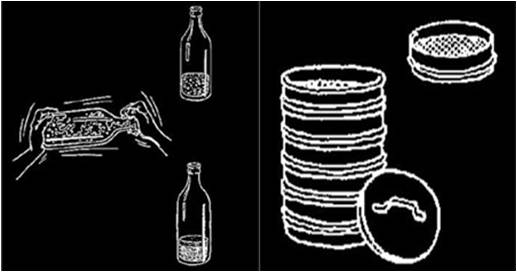
SIEVE TEST
- Procedure
- Pass soil from series of standard sieves set on top of on another with finest sieve at bottom.
- Observer the soil collected in each sieve.
- Interpretation
- Silt will be collected in lowermost sieve.
- Gravels will be collected on top.
- Sand and lumps of clay will be collected in intermediate sieves
SEDIMENTATION TEST
- Procedure
- Take a transparent cylindrical bottle or jar of 1Lt. Capacity.
- Fill it with ¼ soil and ¾ water.
- Shake well and allow it to settle for 30 min.
- Interpretation
- Coarse gravels will be settled at bottom, followed by sand, silt and clay on top.
- Measuring the layers will give us the approximate proportions of each content.
STABILISERS
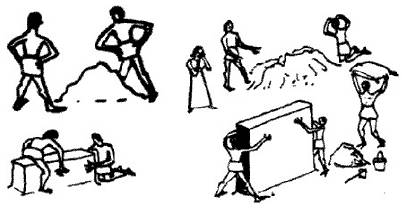
- When the available soil is not suitable enough for construction then the soil can be used by manipulating its composition by adding suitable stabilizers.
- Stabilizing enhances the given property of the soil type.
- Increase Tensile and Shear strength.
- Reduce shrinkage.
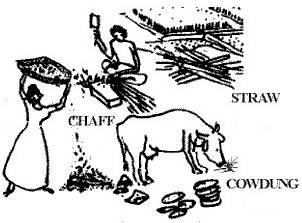
- Most common and effective stabiliser is Soil itself.
- Cement, is the best example of a modern contemporary stabiliser.
- Various other indigenous stabilisers include
- Straw
- Plant Juices
- Gum Arabic
- Sugar Or Molasses
- Cow Dung
- Animal Urine
- Tannic Acid
- Oil
EARTH TECHNIQUES
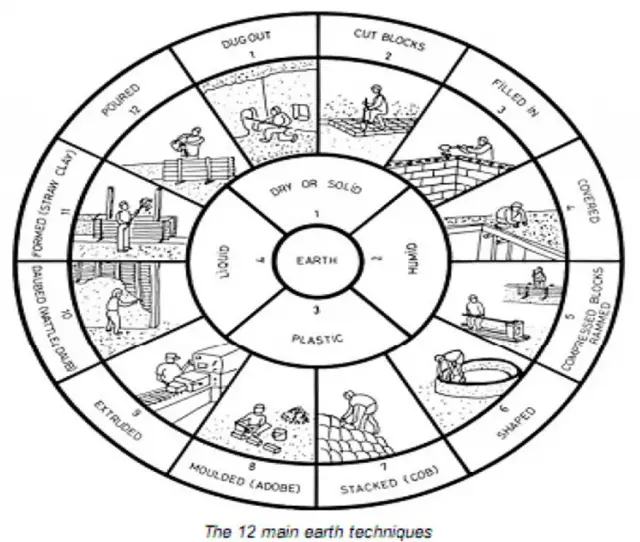
- Cob
- Pise or Rammed earth
- Adobe
- Pressed bricks
- Wattle and daub method
SYSTEMS OF BUILDING

- COB is good for anything except height. It is particularly good for curved or round walls.
- PISE OR RAMMED EARTH is strong and ideal for solid, squat, single storey houses.
- ADOBE or SUN DRIED BRICKS can easily cope with two storey houses.
- PRESSED BRICKS smooth and very strong and can build three storey.
- WATTLE & DAUB is elegant and fine for Seismic Zones.
COB

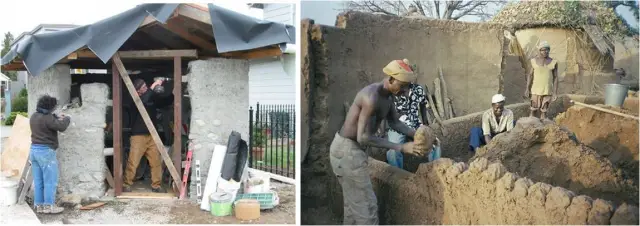
- With only a little water to form a very stiff mud, a large lump is roughly moulded into the shape of a huge elongated egg.
- The usual size is anything between 12 to 18-inches, (30 to 40-cm) long and about 6-inches (15-cm) in diameter.
- A row of these cobs of mud are laid neatly side-by-side – preferably somewhat pressed together.
- Then another row of cobs is laid on top.
- When three or four courses have been laid, one above the other, the sides are smoothed over so that the holes and cracks disappear.
- Openings for doors, and windows are a problem, which can be solved by using temporary vertical planks or shuttering.
- Another very simple shuttering for openings is to use empty kerosene tins.
RAMMED EARTH
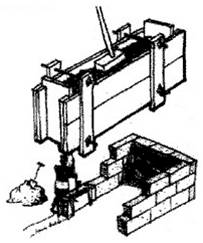
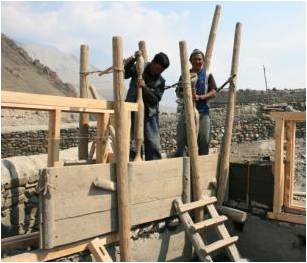
- The second method has developed from the cob wall so as to standardize or regularize the thickness of the wall.
- It is also an attempt to increase the strength of the wall by ramming it. It is known as the Rammed Earth method.
- Two parallel planks are held firmly apart by metal rods and clips or bolts, or by small crosspieces of wood.
- Stiff mud is thrown in between these two planks and rammed down with either a wooden or metal ramrod.
- When one section is completed and hard, the two boards are moved along and the process is repeated
- The two planks are then raised up and a second course of rammed earth is repeated over the first.
ADOBE
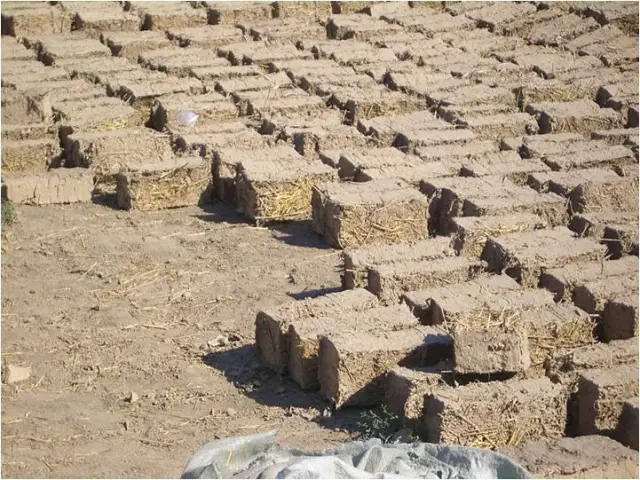

- Blocks shall be kept covered with air tight polythene sheets for first 48 hrs with relative humidity up to 100.
- Polythene sheets shall be removed after 48 hrs and the blocks shall be kept in shaded area like having enough air circulation.
- Sprinkle water over blocks daily, as many times needed, during 28 days.
- Write date of production on block corner.
- Cover stacks top with coconut leaves or any other cover to avoid direct sunlight.
- Principle is that blocks shall not dry for 4weeks.
WATTLE AND DAUB
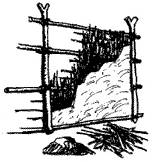
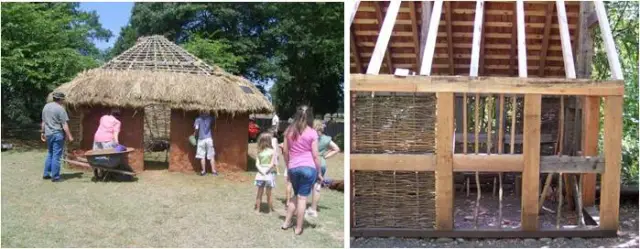
- Wattle and daub method is an old and common method of building mud structures.
- There bamboo and cane frame structure that supports the roof.
- Mud is plastered over this mesh of bamboo cane and straws
- Due to excessive rainfall the Wattle and Daub structures gets washed off.
- However, the mesh of cane or split bamboo remains intact and after the heavy rain is over the mud is plastered on again.
EARTHBAG CONSTRUCTION
- This method was developed from the bunkers made by the military
- The basic construction method begins by digging a trench.
- Rows of woven bags (or tubes) are filled with available inorganic material
- After the foundation is laid, each successive layer will have one or more strands of barbed wire placed on top.
- The weight of this earth-filled bag pushes down on the barbed wire strands, locking the bag in place on the row below.
- The most popular type of bag is made of woven polypropylene.
- Organic/natural materials such as hemp, burlap or other natural-fiber bags (like “gunny sacks”) can be used.
FOUNDATION
- Often it is feasible to build the walls of a home on mud, but some more solid material is needed for the foundation and basement.
- If stone is locally available it can be used.
- There are times when the topsoil may be soft and useless but there may be reasonable harder subsoil capable of carrying the weight of a single storey mud house. In this situation remove the soil from the trench you would normally dig for a stone or brick foundation.
- Slightly dampen the excavated soil and then replace a part of it to fill the trench about 6 to 9-inches. Ram this very hard – then repeat until the trench is full.
- If there is bamboo is available, it can be used to make narrow rafts of split bamboo. Having done the first 6-inches infilling and ramming, a raft of bamboo strips is laid all around.
MORTAR
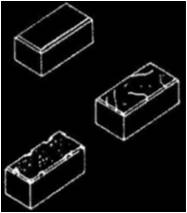
SUITABLE MORTAR FOR MASONRY
- Stabilised Earth Mortar is best suited for masonry using mud blocks.
- Mud mortar shall be stabilised 1.5 times more than the mud blocks.
- Add course sand (0.2 to 2mm) to reduce shrinkage.
- Prepare plastic mix rather than dry mix.
- Ideal mix = soil suitable for mud block + 40% to 50% of sand by weight + 7.5% cement.
Test the mortar before use
- Procedure
- Start with a mix of 1 vol. Cement + 6 vol. Soil + 6 vol. Sand.
- Apply a layer of 1cm mortar on a block soaked in water and let it dray in shade.
- Observe the mortar for cracks.
- Interpretation
- If cracks appear, reduce the soil and increase the sand proportion. 1 cement + 5 soil + 7 sand.
- If mortar is too crumbly, increase the soil and reduce the sand proportion. 1 cement + 7 soil + 5 sand
TREATMENT
TERMITES
- Mud is the natural home of termites so in areas where they are common the same precautions have to be taken as in all buildings to prevent their moving up into the walls and eating wooden frames etc.
- A one-inch thick layer of mortar (one part of cement to 3-parts of sand) can be laid all over the top of the basement wall before building the mud walls above it. This is helpful in keeping out both termites and damp.
- Even better is to construct an apron of burnt brick or stone (or it can be rammed earth) all round the building (to prevent damage to the walls by splashing, of rain water) and this too can be plastered over with a rich cement mortar.
- Any thin sheet metal may be laid over the basement wall with a 3-inch downward projection before starting to build the superstructure mud wall above. This is expensive but very effective.
- There are various chemicals on the market, which can be used.
WATER
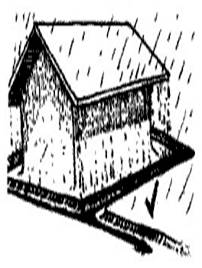
- Water and dampness are one of the major problems for mud as construction material.
- The best way of protecting any wall from either rain or sun is to have a good big overhang to your roof.
- The sloping, or pitched roof is better because the walls need not be so high as for a flat roofed house.
- Provide trenches round the house to receive dripping water and drain it away.

Beautiful post.. Done a good
Beautiful post.. Done a good study on the mud architecture. I want to ask something.
How far it will be good to use mud as construction material in a place with humidity almost 90% in average and monsoon also strikes. Or is it a bad idea of doing it with mud. Please help me out.
great article!
great article!
good information for me. sir
good information for me. sir iw ant to ask that is mud construction favourable for rainy areas like naintal, where rainfall is heavy. could it be stable or i think of something else? please suggest me
can mud architecture be used
can mud architecture be used near dam back water to make villas
Good information for me & my
Good information for me & my students, for the new design problem based on mud construction techniques.
i want to a case study of a
i want to a case study of a mud structure which is more then 75years old nearby munbai, or within maharastra (india)…
plz could you suggest me some structure/settlement
plz rly soon
yeah…nice page
yeah…nice page
Please correct me if I am
Please correct me if I am wrong, but learning from Auroville studies, Mr. Laurie Baker, Anna Heringer, Martin Rauch and many others…A good hat and shoes are sufficient protection!
Therefore, if a good foundation is coupled with a well designed roof, the mud structure can be protected from over exposure to rains.
In extreme conditions with very heavy rainfall, Compressed Stabilized Earth Blocks or stabilized rammed earth (with cement/lime stabilization) can be used.
Also waterproofing of stabilized earth with lime, alum, tanin, bitumen, some resins etc. is helpful.
Examples :
1) Training Centre of the Auroville Earth Centre (where even the foundations are made of earth!)
2) Handmade School in Rudrapur, Bangladesh (crazy monsoons!)(Anna Heringer – Aga Khan Award 2007)
very interesting and
very interesting and knowledgefull aticle.it helps me to get information for my presantation. thank u so much
again thanks
I have read your article and
I have read your article and ideas about mud house and impressed about it. Now I have one farm house project which having a 92 unit of each 22000 sq, ft. in 60 acre at near Nagpur, Maharashtra, India and I am interested to build mud house in every unit , so I want to know total ideas about it and cost of each mud house and who will take a contract of it so that I can have inform to my customers
Its a Great Work.
Its a Great Work.
its awesome
its vry much
its awesome
its vry much helpful fr my exam
thnk u so much fr the info
Please let me know the
Please let me know the technique with which I can do plastering with mud, clay etc of my house inside wall for esthetic puspose and cost effective insultion purpose and how much would be approximately cost involved.